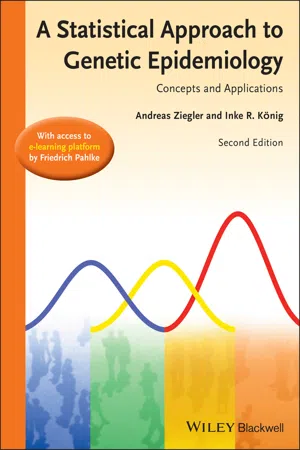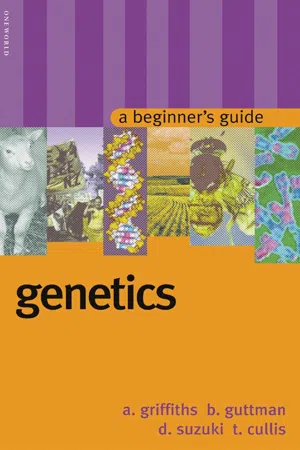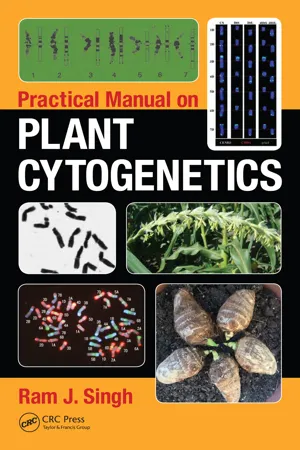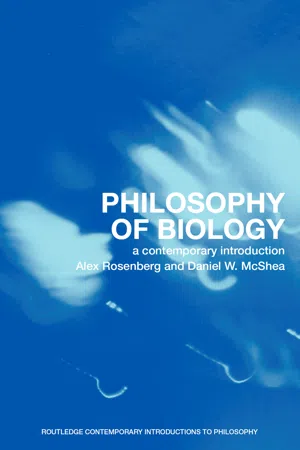Biological Sciences
Law of Independent Assortment
The Law of Independent Assortment states that during gamete formation, the segregation of one gene pair is independent of the segregation of another gene pair. This means that the inheritance of one trait does not affect the inheritance of another trait, and the genes for different traits are inherited independently of each other.
Written by Perlego with AI-assistance
Related key terms
4 Key excerpts on "Law of Independent Assortment"
- eBook - ePub
A Statistical Approach to Genetic Epidemiology
Concepts and Applications, with an e-Learning Platform
- Andreas Ziegler, Inke R. König, Friedrich Pahlke(Authors)
- 2011(Publication Date)
- Wiley-Blackwell(Publisher)
The first and second laws describe the distribution of traits controlled by a single gene. Under ordinary circumstances, the first generation after crossing two different homozygotes contains heterozygotes that look the same. For example, when investigating pea color, Mendel crossed homozygous yellow peas with homozygous green peas, and all of the offspring ended up being heterozygous yellow. However, crossing individuals from this generation led to different traits in the next generation. In this special case, both yellow and green peas emerged. To be specific, with a ratio of 1:2:1, the offspring was homozygous yellow, heterozygous yellow, and homozygous green.The law of independence states that two genetic factors are transmitted independent of each other. Consider as an example the pedigree in Figure 2.2 . Here, we have two genetic loci, the first showing the alleles 1, 2, 3, and 4, the second with A , B , C , and D . Both parents are heterozygous at each locus. Mendel’s law now states that if the mother has alleles 1 and 2 at the first and A and B at the second locus, her children will inherit 1 with A , 1 with B , 2 with A , and 2 with B at about equal frequencies, as is shown in the second generation of the pedigree. The same holds for the alleles of the father.Fig. 2.2 Mendel’s third law, the Law of Independent Assortment. Two genetic loci are shown, the first having alleles 1 to 4, the second A to D . Both parents are heterozygous at each locus. Mendel’s law states that the children will inherit parental alleles from both loci independently.Now, is this a realistic assumption for human genetic loci? After describing the organization of genes in chromosomes in Chapter 1, we know that this is true only for genetic loci that are located on different chromosomes. In this situation, it is a matter of pure chance whether after meiosis they might end up in the same gamete or not. The situation is different for genes on the same chromosome. Here, we would expect them to be transmitted together, as they are physically on the same chromatid. However, because of the recombinations in crossing over events (see Section 1.2), genetic loci on the same chromatid might be separated and not inherited together. These deviations from Mendel’s Law of Independent Assortment will lay the foundation for genetic linkage analysis (see Chapter 7). - eBook - ePub
Genetics
A Beginner's Guide
- Burton Guttman, Anthony Griffiths, David Suzuki, Tara Cullis(Authors)
- 2002(Publication Date)
- Oneworld Publications(Publisher)
What is the probability that you’ve inherited his a allele? Well, the chance that your mother received it from him is ½ and the chance that you received it from her is ½, so the probability is ¼. This is just like flipping a coin twice in a row. The probability is exactly the same that you have received any specific allele from any gene pair in any grandparent. When would two events not be independent? Suppose for some reason that an A egg tends to attract A -bearing sperm and an a egg tends to attract a -bearing sperm. Then in a mating of an Aa male and an Aa female, both producing equal numbers of A and a eggs, the probabilities of getting the various offspring would be skewed from what we usually expect, since fertilization would not occur at random. two or more genes An important application of these concepts of probability is in predicting the results of crosses where we follow two or more genes simultaneously. Mendel performed such experiments, in which he followed characters such as seed color and seed shape together, and they led him to a second important principle, the Law of Independent Assortment : the alleles of two genes assort independently when gametes are being formed. In Chapter 5, we will show how Mendel’s laws follow from the way chromosomes move during cell division. Mendel knew nothing about chromosomes and their behavior in reproduction, and he derived the Law of Independent Assortment strictly from patterns of inheritance, but he was lucky. We shall see later that many genes occur together on the same chromosome and therefore tend to be inherited together, so these are not independent events. However, it just happened that the genes for all the characters that Mendel studied are on different chromosomes (or are so far apart on one chromosome that they are essentially independent) - eBook - ePub
- Ram J. Singh(Author)
- 2017(Publication Date)
- CRC Press(Publisher)
10 Classical Methods for Associating Genes with the Chromosomes10.1 IntroductionThe science of genetics relates to heredity and variation/continuity of life. Cell division, mitosis and meiosis, and precise DNA replication predicts the inheritance of a particular trait from parents to the progenies. A clear understanding of the mode of inheritance is revealed by the science of genetics and its foundation was laid by J. G. Mendel in 1865, based on experiments on the garden pea (Pisum sativum L.). The selection of garden pea was a wise choice because: (1) it is self-pollinated plant and pollination can be controlled, and selfing of F1 posed no problem; (2) it is easy to cultivate this plant and requires only a single growing season; (3) it has many distinguishing sharply defined inherited traits located on different chromosomes and independently segregated (Table 10.1 ); (4) it has 2 n = 14 chromosomes. However, Mendel’s laws were unrecognized until 1900 and this may be due to number of special reasons (Strickberger 1968 ). The variability among the F2 and further hybrid generations could be traced to the original variability in the first parental cross. The factors that could be traced were followed and did not change during the period of observation, but only expressed themselves in new and different combinations among the offspring.TABLE 10.1Relationship between Modern Genetic Terminology and Character Pairs Used by Mendel (Blixt 1975 )Character Pair used by Mendel Alleles in Modern Terminology Located in Chromosomes Seed color: yellow-green I-i1 Seed coat and flowers: colored-white A-a1 Mature pods: smooth expanded-wrinkled V-v4 Inflorescences: from leaf axils—umbellate in top of plant Fa-fa4 Plant height: >1 m-around 0.5 m Le-le4 Unripe pods: green-yellow Gp-gp5 Mature seeds: smooth-wrinkled R-r7 Mendel used discontinuous traits while at that time scientists were looking for continuous variation (Galton, Darwin, and others). Mendel’s approach with probability events and mathematical ratios was an unfamiliar idea to biology. Mendel was in constant correspondence with Nägeli who did not appreciate Mendel’s work because he was working with Hieracium (hawkweed), an apomictic plant an F1 hybrid did not segregate; all F2 - eBook - ePub
Philosophy of Biology
A Contemporary Introduction
- Alex Rosenberg, Daniel W. McShea(Authors)
- 2007(Publication Date)
- Routledge(Publisher)
It does not take much more examination than that to conclude that Mendel’s laws are not, after all, really laws at all. Mendel did his famous experiments on pea plants in the mid-nineteenth century. His published results went unnoticed until rediscovered in the early twentieth century and, since then, a major theme of the history of genetics has been the discovery of more and more exceptions to his laws. Luckily for Mendel and for genetics, the traits he first studied did not happen to involve genes located close together on the same chromosomes. Had they been so “linked,” that is lying close together on the same chromosome, they would not have assorted independently. Once linkage was detected, it became clear that the second law is a rough and ready generalization with enormous numbers of exceptions, such as those arising from linkage. As for the law of segregation, geneticists now know cases in which segregation is unequal, in which one of the two alleles is preferentially transmitted to the next generation, the so-called segregation distorter alleles.Of course, just because Mendel’s principles are not laws does not mean that they are not important in biology. What it does mean is that when they are successfully applied in prediction, and when they are not, is a matter to be explained by appeal to other more fundamental regularities. In the case of Mendel’s laws, these will be regularities about meiosis and other details of cell physiology. Is that where the laws are? Somewhere in these lower level processes, is that where we will find the fundamental causal laws of biology that explain Mendelian generalizations and their exceptions?The answer is almost certainly not. Again, the reason goes back to Darwinian theory. For the theory tells us that meiosis, segregation, and assortment are—like other features of organisms such as genes, chromosomes, and sexual reproduction—the result of a long evolutionary history. In the course of that history, natural selection produced adaptation, including both the Mendelian processes themselves—such as meiosis that produces segregation—and other non-Mendelian processes, some of which—such as segregation distorters—take advantage of Mendelian processes. Future environmental changes could modify meiosis further, or even do away with it altogether. Similarly, if natural selection is operating on other worlds circling other suns, we have some reason to suppose that there will be replicators and perhaps also interactors on these worlds but little reason to suppose that they will reproduce by meiosis, or that anything like Earthly sexual physiology will have emerged. The domain of any laws that we discover about sexual processes, or about anything else in biology, could well be quite limited, that is to say limited to a single instance of biology here on Earth and further limited to a particular time range in Earthly evolutionary history.
Learn about this page
Index pages curate the most relevant extracts from our library of academic textbooks. They’ve been created using an in-house natural language model (NLM), each adding context and meaning to key research topics.



